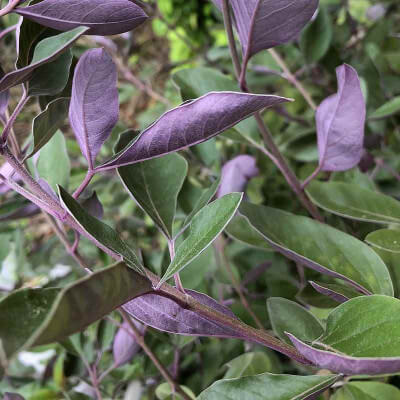
Vitex trifolia, commonly known as the Arabian Lilac, is a tropical shrub highly valued for both its ornamental appeal and its many beneficial properties. Native to the coastal regions of tropical Asia and Oceania, it belongs to the Lamiaceae family. This fast-growing plant typically reaches between two and four metres in height and is easily recognisable by its spreading habit and dense foliage. Its distinctive trifoliate leaves are dark green on top and silvery underneath, creating a striking visual contrast—perfect for enhancing tropical gardens such as Au Bois Vert in Ivato, near Antananarivo.
The Arabian Lilac blooms throughout the year, with peak flowering occurring during the warmer seasons. Its small, tubular flowers range in colour from soft mauve to bluish violet and form delicate, eye-catching spikes. Lightly fragrant, they attract a variety of pollinators, particularly bees and butterflies, which in turn supports local biodiversity.
This shrub thrives in coastal environments, particularly in well-drained soil, and shows a strong tolerance to salty sea air. At the Au Bois Vert botanical garden, it plays a central role in beautifying the landscape while offering pleasant shaded areas. For this reason, hotels, restaurants, and lodges around Antananarivo frequently incorporate the Arabian Lilac into their landscaping, not only for its aesthetic charm but also for its ability to withstand diverse climatic conditions. Its evergreen foliage ensures it remains a decorative feature all year round.
With so many advantages, Vitex trifolia has become a staple of the botanical garden. It perfectly captures the essence of tropical beauty while meeting practical landscaping needs—especially in a setting like Ivato.
Plant use
The Arabian Lilac, or Vitex trifolia ssp. litoralis, holds a significant place both in horticulture and traditional medicinal practices. In gardens and green spaces, this shrub is commonly used to form hedges or natural borders. Its dense foliage and spreading habit make it an effective windbreak, while also helping to prevent soil erosion in coastal areas. Landscape designers particularly value its ability to withstand salty spray and sea winds, making it a practical choice for tropical regions such as Antananarivo and its surroundings. From a medicinal perspective, many cultures have long turned to the leaves and flowers of this shrub for their therapeutic properties. In traditional medicine, leaf extracts are used to treat inflammation, skin infections, and certain respiratory conditions. Moreover, the flowers and seeds contain antioxidant compounds that are often incorporated into natural remedies or skincare products. In the hotels and lodges around Ivato, this shrub is frequently found in landscaped areas thanks to its ornamental appeal and ease of maintenance. Its regular flowering and soothing shades contribute to the calm and welcoming atmosphere of these establishments. The Au Bois Vert botanical garden also showcases this plant to raise awareness of its ecological role. Its presence supports biodiversity by providing both habitat and nourishment for a variety of pollinating species. In this way, Vitex trifolia ssp. litoralis combines beauty, utility, and resilience, making it an essential plant for tropical landscaping. At the Au Bois Vert botanical garden, it blends seamlessly with other species, reflecting the richness and diversity of tropical flora.
Key information
| Common name | Arabian Lilac |
| Scientific name | Vitex trifolia |
| Origin | Tropical Asia, Oceania |
| Natural habitat | Coastal regions, well-drained soils |
| Life cycle | Perennial |
| Flowering period | All year round (peaks in the warmer seasons) |


